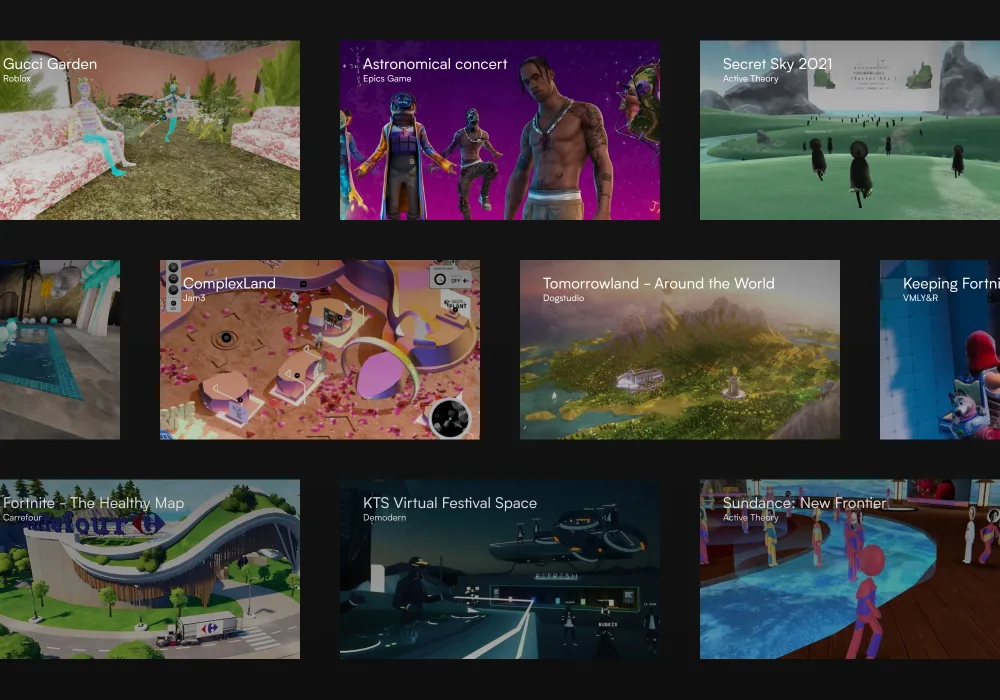By Nicolas Rajabaly, Co-founder and Chief Creative Officer of makemepulse
Over the past 18 months, the pandemic has forced us to replicate in a digital environment what we couldn’t do in person: from AR makeup try-on to virtual film festivals and concerts. But what started out as a commercial survival strategy has become something much bigger, and all the signs are that it’s here to stay.
Enter the metaverse.
Having recently hit the headlines when Mark Zuckerberg announced he wanted to turn Facebook into a ‘metaverse’ company, the concept is still mysterious to many outside the gaming world. We can thank Neal Stephenson’s novel Snow Crash – which envisaged the internet as a 3D virtual living space, where people work, play and socialise in real time – for its dystopian connotations, but the real definition of a metaverse is much broader. Simply put, it’s about removing the physical barriers between the digital world and the real one, so that an experience in the digital arena is as easy as in the real world.
It might sound like the stuff of sci-fi films, but precursors to the metaverse are already here in the form of cult games like Fortnite, Animal Crossing and Roblox. Lured by the promise of huge, previously untapped audiences – Fortnite has 350 million players worldwide, Roblox has 42 million daily active users – it’s no surprise that brands and artists are experimenting with events in these virtual spaces. Travis Scott’s Astronomical concert, which attracted more than 12 million players, was hailed as ‘the live music event of 2020’, and the US rapper isn’t alone in testing the waters of the metaverse via the world’s biggest online game. Fast food chain Wendy’s ‘declared war on frozen beef’ with its Keeping Fortnite Fresh activation, while French supermarket Carrefour launched a ‘healthy map’, where players could gain energy through fruit, vegetables and fish. Over on Roblox, Gucci created an immersive Gucci Garden experience where avatars could explore, mingle with others and buy limited-edition digital pieces.
While such activations certainly generate buzz and plenty of PR, they’re short-lived and don’t allow brands to capitalise on their new visibility in the long term. Gaming platforms are certainly an interesting field for luxury marques to explore, but not necessarily one which will allow them to reach their entire audience. Plus, by yoking their marketing to the likes of Fortnite, brands are falling into a similar trap of five years ago, merely substituting one behemoth (Facebook) for another (Epic Games).
Making the metaverse a reality
So how can brands, artists and cultural institutions bring their metaverses out of the gaming world and into the mainstream to connect with the average person? How can they create an impact that lasts longer than a couple of hours, days or weeks?
Rather than waiting for a Mark Zuckerberg figure to take the next step, and then paying for space in an all-encompassing metaverse, it’s time for brands to be brave and innovative and to create their own independent virtual worlds, where every experience is controlled and owned by the brands themselves.
Imagine hanging out with your friends in the Netflix metaverse every Sunday night ready to watch a movie together. Meeting new fan-friends while watching a Beyoncé concert in her metaverse, all experiencing a multisensory show together. Visiting the latest exclusive NFT exhibition in the MoMA metaverse with your family. Or being able to test drive all the new BMW cars in their virtual garage.
Thanks to the pandemic, many cultural institutions behind IRL events have taken steps in that direction. Last year, popular music festivals including Secret Sky, Tomorrowland and Kollektiv Turmstrasse recreated the festival experience digitally via custom designed immersive WebGL experiences for mobile and desktop users. Meanwhile attendees of indie film festival Sundance 2020 got to watch films, explore an XR art gallery, and socialise through video and voice chat thanks to its New Frontier Experience, a connected web and VR event. And pop culture exhibition ComplexCon was reimagined as a gamified shopping experience, Complexland, where customers could customize their avatars, travel around a 3D map, and compete for exclusive product drops.
While all the examples above have a gaming component, it’s important for brands to realise there’s no ‘one size fits all’ approach when it comes to creating a metaverse. A metaverse that involves avatar creation and digital recreation of a figurative space, where you can move freely and discover things, is just one version of many millions of possibilities. Contrast that with a potential Netflix ‘plaza’, where you can meet your friends, hang out, and watch the next movie that’s being projected inside together.
Nor does a metaverse need specialist hardware like VR headsets. Mark Zuckerberg may imagine us all teleporting into meetings wearing our Oculus headgear, but most people would prefer to access a virtual world by typing in a URL into their browsers, and from a technological point, that’s easy to do – it simply involves creating an additional, metaverse version of the brand’s dotcom website.
When it comes to marketing, the metaverse should be part of a brand’s creative process from the beginning: a creative idea that can play out on different channels. By having a timeline on the metaverse which reflects the brand calendar, specific content can be created to mark special occasions or anniversaries. Metaverse events don’t need to replace physical events, such as product launches: after all, we all need to see other people in real life. But they can usefully run in tandem – so that if someone can’t attend the ‘real’ event for Covid-related or environmental reasons, they can still join in virtually.
In summary, the metaverse isn’t about a world where people go to forget themselves and live their lives entirely through VR. Instead, it should be seen an extension of the brand world, making it easier and more natural for consumers to interact with brands. So, let’s leave sci-fi to the film industry – and bring metaverses into the mainstream.









